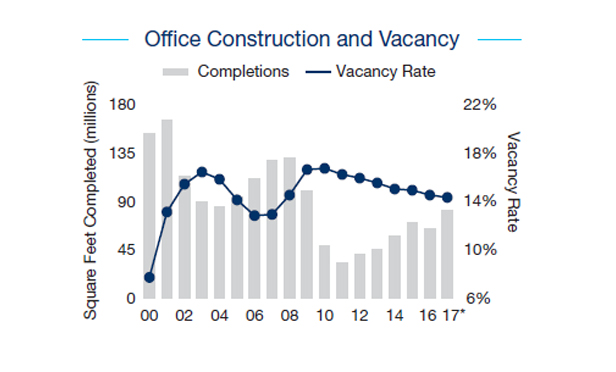 US vacancy rates have declined for six straight years.
US vacancy rates have declined for six straight years.
CALABASAS, CA—Four factors contribute to what is shaping up to be a positive outlook for the national office sector, according to a newly released report from Marcus & Millichap. First are the fundamentals: Growing demand and declining vacancy make for growth in rental rates in both the CBDs and, somewhat surprisingly, the suburbs. But there are also changes taking place in usage, pushing the sector to a more vibrant part of the market that is responding to a new generation of user need.
“The decline in the US vacancy rate in 2016 marked the sixth consecutive annual decrease and also highlighted emerging trends that could become more firmly entrenched,” the report states. Net absorption of roughly 83 million square feet will just surpass the 82 million feet of completions anticipated for the year to produce a 14.3% vacancy rate—a 20-basis-point decline over last year. And tightening vacancies will naturally lead to a rise in rents, which the report tags at 3.5%.
There has been much ink of late given to the re-emergence of the CBDs, but Marcus & Millichap research shows that the suburbs too are regaining ground: “Beyond 2017,” the report predicts, “construction will likely occur in select suburban locations with walkable central cores and access to major transportation routes and mass transit, factors that are becoming increasingly important to office tenants.”
For this, we have the millennials to thank, at least in part. “A growing number of newly formed millennial families will migrate to ‘urbanized’ suburbs with walkability and proximity to city centers, making office assets in those types of locations a compelling investment opportunity,” says the report.
That growing cohort is having its way not only with the location of space, but also in usage. “As the millennial generation reshapes the workforce, tenants will favor assets that engender community and cohesion. Popular amenities include recreation spaces, on-site medical offices, restaurants and childcare centers.”
For the full report, click here.

















 Copyright © 2024 ALM Global, LLC. All Rights Reserved.
Copyright © 2024 ALM Global, LLC. All Rights Reserved.